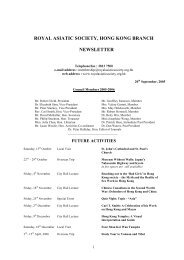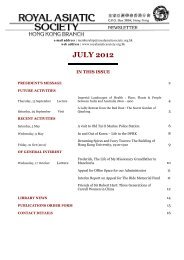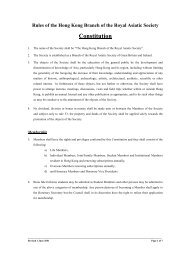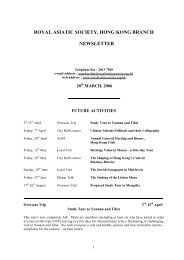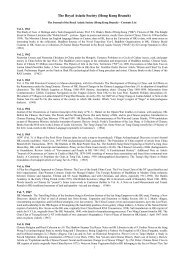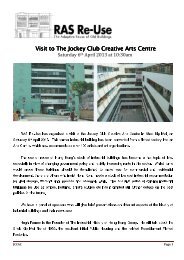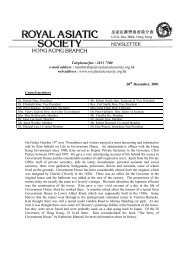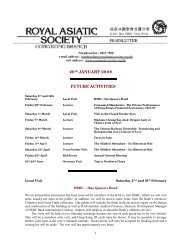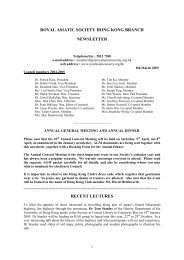of interest to members - Royal Asiatic Society Hong Kong Branch
of interest to members - Royal Asiatic Society Hong Kong Branch
of interest to members - Royal Asiatic Society Hong Kong Branch
You also want an ePaper? Increase the reach of your titles
YUMPU automatically turns print PDFs into web optimized ePapers that Google loves.
Telephone/fax : 2813 7500<br />
e-mail address : <strong>members</strong>hip@royalasiaticsociety.org.hk<br />
web address : www.royalasiaticsociety.org.hk<br />
Council <strong>members</strong> 2003-2004<br />
20 th August, 2003<br />
Dr. Patrick Hase, President Mr. Robert Nield, Hon. Treasurer & Vice President<br />
Dr. Elizabeth Sinn, Vice President Rev. Carl Smith, Hon. Vice President<br />
Mr. Peter Stuckey, Hon. Secretary Miss Julia Chan, Hon. Librarian<br />
Dr. Janet Lee Scott, Hon. Activities Co-ordina<strong>to</strong>r Dr. Peter Halliday, Hon. Edi<strong>to</strong>r <strong>of</strong> Journals<br />
Mrs. Valery Garrett, Member Mrs. May Holdsworth, Member<br />
Mr. Tim Ko, Member Dr. Joseph Ting, Member<br />
Mr. Jason Wordie, Member Mr. Robert Horsnell, Co-opted Member<br />
Dr. Dan Waters, Immediate Past President Dr. Betty Wei, Co-opted Member<br />
We have great pleasure in welcoming Dr. Betty Wei Peh T’i as a newly co-opted member <strong>of</strong> the Council.<br />
Betty is Head <strong>of</strong> Liberal Arts and Interdisciplinary Studies at the <strong>Hong</strong> <strong>Kong</strong> Academy for Performing Arts.<br />
She is a graduate <strong>of</strong> Bryn Mawr College, New York University, and the University <strong>of</strong> <strong>Hong</strong> <strong>Kong</strong>. She also<br />
holds honorary appointments at the Institute <strong>of</strong> Qing His<strong>to</strong>ry at the People's University in Beijing, and the<br />
Centre <strong>of</strong> Asian Studies and the Department <strong>of</strong> His<strong>to</strong>ry at the University <strong>of</strong> <strong>Hong</strong> <strong>Kong</strong>. She is the author <strong>of</strong><br />
many scholarly and journalist articles in English and in Chinese. Her best known full-length publications are<br />
Shanghai: Crucible <strong>of</strong> Modern China (Oxford University Press) and Cultural Shock: <strong>Hong</strong> <strong>Kong</strong> (Times<br />
Books).<br />
Regarding Vicky Lee’s <strong>interest</strong>ing talk on 30 th May on the subject <strong>of</strong> Eurasianness, Vicky has written <strong>to</strong> us<br />
concerning two factual errors in our write up <strong>of</strong> her talk in our June newsletter. In the last paragraph <strong>of</strong> our<br />
write up, it says “two ‘pure British’ women were said <strong>to</strong> have pointed out those who were Eurasian, including<br />
Joyce Symons”. Vicky did in fact mention in her talk that Joyce Symons herself had been denied evacuation,<br />
so she was not one <strong>of</strong> those <strong>to</strong> be weeded out in Manila. But, being part <strong>of</strong> the war-time Eurasian community,<br />
she recalls what she knew about the incident at that time. Vicky also points out that Joyce Symons is not “the<br />
Rev. Joyce Symons” but Dr. Joyce Symons. Please accept our apologies for these errors, Vicky.<br />
On Friday 13 th June, Pr<strong>of</strong>essor Gregory James, Direc<strong>to</strong>r <strong>of</strong> the Language Center at the <strong>Hong</strong> <strong>Kong</strong> University<br />
<strong>of</strong> Science & Technology, gave a lively account <strong>to</strong> <strong>members</strong> <strong>of</strong> the discovery <strong>of</strong> a rare manuscript - an<br />
unpublished report <strong>of</strong> missionary activity in China. Together with his colleague Mr. David Morgan, (a<br />
member <strong>of</strong> the RASHKB), the manuscript was translated from Spanish in<strong>to</strong> English. New knowledge came <strong>to</strong><br />
light in translation, and certain events and fallacies were made clear.
Pr<strong>of</strong>essor James began with a brief his<strong>to</strong>ry <strong>of</strong> Franciscan activity in China, then explained how the book came<br />
<strong>to</strong> be written. St Francis <strong>of</strong> Assisi founded the Order <strong>of</strong> Franciscans in 1209, and missionary activity was very<br />
important <strong>to</strong> the Order. The Franciscans first went <strong>to</strong> China in the middle <strong>of</strong> the 13 th century, though it is <strong>of</strong>ten<br />
assumed incorrectly that Jesuit fathers, Matteo Ricci and Michael Ruggieri, were the first <strong>to</strong> set foot there in<br />
the late 16 th century. In the centuries that followed, the Franciscans were keen <strong>to</strong> go back <strong>to</strong> China. But they<br />
couldn’t go via Portuguese Macau since the Jesuits had a firm base there. So the conquest <strong>of</strong> the Philippines<br />
by Spain was welcomed as a stepping-s<strong>to</strong>ne <strong>to</strong> China, for the Spaniards were after two things - “Spices and<br />
Christians”.<br />
Mr. Dave Morgan then described his recent trip <strong>to</strong> the western part <strong>of</strong> Hainan Island. He was following in the<br />
footsteps <strong>of</strong> two Franciscan monks who had sailed from the Philippines, en route <strong>to</strong> Vietnam, and were<br />
shipwrecked <strong>of</strong>f the coast <strong>of</strong> Hainan. Pr<strong>of</strong>essor James <strong>to</strong>ok up the s<strong>to</strong>ry once more <strong>of</strong> how they were captured<br />
on Hainan, and ill treated until their eventual release by the mandarin in Zhaoqing.<br />
A large and appreciative audience attended the talk at City Hall on 27 th June given by Dr. Graeme Lang,<br />
Associate Pr<strong>of</strong>essor in the Faculty <strong>of</strong> Humanities and Social Sciences at City University <strong>of</strong> <strong>Hong</strong> <strong>Kong</strong>. His<br />
talk was entitled, “The Return <strong>of</strong> the Refugee God: Wong Tai Sin in China”. Well illustrated with <strong>interest</strong>ing<br />
transparencies, Dr. Lang spoke about the how the cult <strong>of</strong> Wong Tai Sin was largely destroyed in China during<br />
the Cultural Revolution <strong>of</strong> the 1960s but <strong>to</strong>day is flourishing in the mainland, in Guangdong and Zhejiang<br />
Provinces.<br />
Dr. Lang pointed out that at least ten new temples <strong>to</strong> Wong Tai Sin have been built, some <strong>of</strong> them huge, staterun<br />
complexes, for which peasants were cleared <strong>of</strong>f the land and millions <strong>of</strong> yuan were spent. Most <strong>of</strong> these<br />
are failures because they are not patronized by worshippers but by <strong>to</strong>urists who are charged a lot <strong>of</strong> money <strong>to</strong><br />
enter and <strong>of</strong>ten leave disappointed. On the other hand, smaller temples are popular with enthusiastic villagers.<br />
In such temples, worship is “alive” and on-going. In Guangzhou, a Wong Tai Sin temple was <strong>to</strong>rn down in<br />
the 1920s but a new one was built on the original site in 1999, and a <strong>Hong</strong> <strong>Kong</strong> businessman, a Mr. Yip, was<br />
granted a 40-year concession and runs it like a mall! It is very successful – in 2001, at Chinese New Year,<br />
more than 60,000 worshippers flocked <strong>to</strong> this temple. The talk concluded with a lively question session.<br />
On 8 th August 2003, Dr. Peter Halliday, Hon. Edi<strong>to</strong>r <strong>of</strong> our <strong>Society</strong>’s Journal since 1992, gave a lecture<br />
entitled “The Birth <strong>of</strong> the Lunatic Asylums in <strong>Hong</strong> <strong>Kong</strong>”, a <strong>to</strong>pic he has researched for more than 15 years.<br />
In the 19 th Century, struggles occurred between the Government, which did not favour building asylums, and<br />
those who felt asylums were a necessity. The Government felt that non-Chinese lunatics could be shipped<br />
back <strong>to</strong> their own countries. The father <strong>of</strong> asylum care in <strong>Hong</strong> <strong>Kong</strong> was Philip Ayres, who lived from 1840<br />
<strong>to</strong> 1899 and was the Colonial Surgeon from 1873 <strong>to</strong> 1897, a great reformer who favoured asylum care, built<br />
hospitals and improved sanitation. In 1885, a “fine, airy building” opened at High and Eastern Streets in Sai<br />
Ying Pun, and in 1891, a Chinese extension was built. The Chinese extension still exists and is used as a<br />
methadone centre.<br />
Dr Halliday showed a number <strong>of</strong> very <strong>interest</strong>ing powerpoint slides <strong>of</strong> 19 th Century correspondence between<br />
<strong>Hong</strong> <strong>Kong</strong> and the Foreign Office in London as well as pho<strong>to</strong>graphs <strong>of</strong> the large building built in 1892 as<br />
nursing quarters for the Civil Hospital. The facade <strong>of</strong> this building was incorporated in<strong>to</strong> a new, multipurpose<br />
social complex only last year. An <strong>interest</strong>ing but puzzling shield-like decoration at the <strong>to</strong>p <strong>of</strong> this<br />
building was discussed during the question-and-answer session following this very <strong>interest</strong>ing talk.<br />
>>>>>>>>>>>>>>>>>>>>>>>>>>>>>>>>>>>>>>>>>>>>>>>>>>>>>>>>>>>>>>>>>>>>>>>>><br />
2
FUTURE ACTIVITIES<br />
Friday, 29 th August City Hall Lecture Chinese Archery – An Unbroken<br />
Tradition?<br />
Saturday, 30 th August Local Visit Guided Tour <strong>of</strong> Asian Traditional<br />
Archery Exhibition at the <strong>Hong</strong><br />
<strong>Kong</strong> Museum <strong>of</strong> Coastal Defence<br />
Friday, 5 th September City Hall Lecture The Fall <strong>of</strong> <strong>Hong</strong> <strong>Kong</strong>: Britain, China<br />
and the Japanese Occupation<br />
Saturday, 20 th September Local Visit Behind the Scenes: A Conservation Tour<br />
The <strong>Hong</strong> <strong>Kong</strong> Heritage Museum<br />
9 th – 12 th Oc<strong>to</strong>ber Seminar/Visits Parsees, Armenians and Muslims in the<br />
Early Nineteenth Century Pearl River<br />
Area<br />
Friday 24 th Oc<strong>to</strong>ber City Hall Lecture Forty Years in <strong>Hong</strong> <strong>Kong</strong><br />
Sunday 26 th Oc<strong>to</strong>ber Local Visit George Smirn<strong>of</strong>f’s Watercolours <strong>of</strong><br />
Macao<br />
Friday, 14 th November City Hall Lecture Sun Yat-sen, <strong>Hong</strong> <strong>Kong</strong> and the Sam<br />
Chau Tin Rebellion<br />
Friday, 21 st November City Hall Lecture Sha Tau Kok Market and its Market<br />
District<br />
22/23 rd November China Visit Sha Tau Kok/Ping Shan<br />
>>>>>>>>>>>>>>>>>>>>>>>>>>>>>>>>>>>>>>>>>>>>>>>>>>>>>>>>>>>>>>>>>>>>>>>>>>>><br />
City Hall Lecture Friday, 29 th August<br />
Chinese Archery – An Unbroken Tradition?<br />
Speaker: Mr. Stephen Selby<br />
Time: 6:15 p.m.<br />
Venue: Extension Activities Room, 8 th Floor, City Hall High Block, Central.<br />
Cost: The lecture is free and open <strong>to</strong> the public.<br />
Booking: No booking is required.<br />
Archery is recorded in China’s literary records from 3,500 years before our time. Wall paintings and<br />
archaeological evidence could push that date back even further. Use <strong>of</strong> the bow and arrow persisted long<br />
after the invention <strong>of</strong> the gun, and died out only after it was abolished from the imperial examination syllabus<br />
in 1901.<br />
What was distinctive about the archery tradition in China? Was there any continuity over the three thousand<br />
years in which it has been practiced? And what does the future hold in s<strong>to</strong>re? Mr. Selby will discuss these<br />
and other issues about archery.<br />
3
Mr. Stephen Richard Selby was born in London and studied at the University <strong>of</strong> Edinburgh, where he <strong>to</strong>ok an<br />
MA Honours Degree in Chinese, and at the Moray House College <strong>of</strong> Education. He is a Fellow <strong>of</strong> the <strong>Royal</strong><br />
<strong>Asiatic</strong> <strong>Society</strong> (UK), and a member <strong>of</strong> both the <strong>Hong</strong> <strong>Kong</strong> <strong>Branch</strong> <strong>of</strong> the RAS and the Oriental Ceramic<br />
<strong>Society</strong> <strong>of</strong> <strong>Hong</strong> <strong>Kong</strong>. He is an Honorary Advisor <strong>to</strong> the Yan Huang Chinese Culture Research Association<br />
in Beijing and the convenor <strong>of</strong> the Asian Traditional Archery Research Network (ATARN).<br />
The lecture will be followed by a visit <strong>to</strong> the newly-opened exhibition <strong>of</strong> Asian Traditional Archery at the<br />
<strong>Hong</strong> <strong>Kong</strong> Museum <strong>of</strong> Coastal Defence on Saturday, August 30th (see below).<br />
>>>>>>>>>>>>>>>>>>>>>>>>>>>>>>>>>>>>>>>>>>>>>>>>>>>>>>>>>>>>>>>>>>>>>>><br />
Local Visit Saturday, 30 th August<br />
Asian Traditional Archery and Bow-making<br />
Guided <strong>to</strong>ur <strong>of</strong> exhibition at the <strong>Hong</strong> <strong>Kong</strong> Museum <strong>of</strong> Coastal Defence<br />
This visit will follow on from the talk the previous evening at City Hall. The speaker, Stephen Selby, will<br />
lead us around this unique exhibition. Due <strong>to</strong> space restrictions, Stephen will take <strong>members</strong> round the<br />
exhibition in groups <strong>of</strong> eight. While waiting, <strong>members</strong> may view the other exhibits in the museum.<br />
There are still a few places left on this visit. If you would like <strong>to</strong> attend, please call Tim Ko and send <strong>of</strong>f the<br />
booking form and your cheque immediately.<br />
Meeting Place: Queen’s Pier, Central (coach)<br />
Meeting Time: 9:30 a.m.<br />
Return: 12:30 p.m. (approx.)<br />
Cost: Members $80. Due <strong>to</strong> limited space, this visit will be limited <strong>to</strong> 30 people (Members only).<br />
Booking: There is a booking form at the end <strong>of</strong> this newsletter. Please return it by 23 rd August, at the latest.<br />
Questions: Tim Ko 9181 6556<br />
>>>>>>>>>>>>>>>>>>>>>>>>>>>>>>>>>>>>>>>>>>>>>>>>>>>>>>>>>>>>>>>>>>>>>>><br />
City Hall Lecture Friday, 5 th September<br />
The Fall <strong>of</strong> <strong>Hong</strong> <strong>Kong</strong>: Britain, China and the Japanese Occupation<br />
Speaker: Mr. Philip Snow<br />
Time: 6:15 p.m.<br />
Venue: Extension Activities Room, 8 th Floor, City Hall High Block, Central.<br />
Cost: The lecture is free and open <strong>to</strong> the public.<br />
Booking: No booking is required.<br />
On Christmas Day 1941 Japanese forces captured <strong>Hong</strong> <strong>Kong</strong> and Britain lost control <strong>of</strong> its colony for almost<br />
four years. The Japanese occupation was a turning-point in the slow his<strong>to</strong>rical process by which the British<br />
were <strong>to</strong> be expelled from the colony and from four centuries <strong>of</strong> influence in East Asia. Philip Snow will<br />
unravel the dramatic s<strong>to</strong>ry <strong>of</strong> the occupation from the viewpoint <strong>of</strong> all the key players and examine the<br />
subsequent evolution <strong>of</strong> <strong>Hong</strong> <strong>Kong</strong> in the light <strong>of</strong> this episode.<br />
Philip Snow graduated from Oxford University with a First Class degree in Chinese. He is the author <strong>of</strong> The<br />
Star Raft: China’s Encounter with Africa and <strong>of</strong> a number <strong>of</strong> shorter works on Sino-African and Sino-Russian<br />
relations. His new book, The Fall <strong>of</strong> <strong>Hong</strong> <strong>Kong</strong>, the product <strong>of</strong> several years <strong>of</strong> research in London and<br />
<strong>Hong</strong> <strong>Kong</strong> and research visits <strong>to</strong> Taiwan and Japan, will be on sale at the lecture.<br />
4
Local Visit Saturday, 20 th September<br />
This visit is open <strong>to</strong> Members Only<br />
Behind the Scenes: A Conservation Tour<br />
This is a special lecture and <strong>to</strong>ur <strong>of</strong> the conservation facilities <strong>of</strong> the <strong>Hong</strong> <strong>Kong</strong> Heritage Museum in Tai Wai.<br />
Mr. Chan Shing Wai, the Chief Cura<strong>to</strong>r for Conservation, will introduce the <strong>members</strong> <strong>to</strong> the special areas <strong>of</strong><br />
conservation and <strong>to</strong> the new Heritage Museum Labora<strong>to</strong>ry.<br />
The Central Conservation Section operates several labora<strong>to</strong>ries at the <strong>Hong</strong> <strong>Kong</strong> Museum <strong>of</strong> His<strong>to</strong>ry, the<br />
<strong>Hong</strong> <strong>Kong</strong> Museum <strong>of</strong> Art, and in Tai Po. However, the facilities at the Heritage Museum are <strong>Hong</strong> <strong>Kong</strong>’s<br />
best-equipped labora<strong>to</strong>ries for the preservation <strong>of</strong> artifacts and antiquities. Participants will be able <strong>to</strong> view<br />
first hand items being processed by the staff and learn what are the latest pr<strong>of</strong>essional techniques. A brief<br />
introduction <strong>to</strong> their work is available on the website http://www.lcsd.gov.hk/conservation.<br />
Meeting Place: Entrance Hall <strong>of</strong> the <strong>Hong</strong> <strong>Kong</strong> Heritage Museum, Tai Wai, Shatin.<br />
Meeting Time: 9:45 a.m.<br />
Return: The visit will end at approximately 1:00 p.m.<br />
Cost: $30 per member. This visit is open <strong>to</strong> Members only and limited <strong>to</strong> 30.<br />
Parking: Pre-arranged parking is available at the museum, (in the covered car park located through the staff<br />
entrance, in the gate after the Caltex service station at the corner); if you wish <strong>to</strong> take your car, please advise<br />
the registration number on the booking form.<br />
Booking: There is a booking form at the end <strong>of</strong> this newsletter. Please return it by 13 th September, latest.<br />
Questions: Dr. Janet Lee Scott. Tel: 3411 7132 (daytime only).<br />
>>>>>>>>>>>>>>>>>>>>>>>>>>>>>>>>>>>>>>>>>>>>>>>>>>>>>>>>>>>>>>>>>>>>>>><br />
Local Seminar Thursday, 9 th Oc<strong>to</strong>ber<br />
Sino-Indian Inter-actions in the 18 th and 19 th Centuries<br />
Parsees, Armenians, and Muslims in Macau, Guangzhou and <strong>Hong</strong> <strong>Kong</strong><br />
A Seminar has been arranged by the Centre <strong>of</strong> Asian Studies, University <strong>of</strong> <strong>Hong</strong> <strong>Kong</strong>, and the Institu<strong>to</strong><br />
Cultural Macau, which will take place at the Centre <strong>of</strong> Asian Studies on Oc<strong>to</strong>ber 9 th 2003. This Seminar will<br />
be open <strong>to</strong> the public.<br />
Among the speakers will be the Rev. Carl Smith, our long-term Vice-President, who will speak on The<br />
Parsees <strong>of</strong> Macau and <strong>Hong</strong> <strong>Kong</strong>, Dr. Paul Van Dyke (who recently spoke <strong>to</strong> the <strong>Society</strong>), who will speak<br />
(<strong>to</strong>gether with the Rev. Carl Smith) on Armenians and Muslims in Macau and the Delta, Dr. Guo Deyan, who<br />
will speak on Parsees in the Delta, and Madhavi Thampi and Shalini Saksena who will speak on Parsees<br />
Trading between India and China.<br />
All <strong>interest</strong>ed Members are urged <strong>to</strong> attend this Seminar, which promises <strong>to</strong> be extremely <strong>interest</strong>ing and<br />
instructive, and which will doubtless illuminate a major facet <strong>of</strong> our his<strong>to</strong>ry. Attendance is free. Lunch will be<br />
available at $150 a head, if wanted.<br />
For further information, please phone Isabelle Saint-Mezard at the Centre <strong>of</strong> Asian Studies, tel: 2241-5824.<br />
>>>>>>>>>>>>>>>>>>>>>>>>>>>>>>>>>>>>>>>>>>>>>>>>>>>>>>>>>>>>>>>>>>>>>>>>>>>>>><br />
5
China Visit 11 th and 12 th Oc<strong>to</strong>ber<br />
Visit <strong>to</strong> Can<strong>to</strong>n and Whampoa<br />
Due <strong>to</strong> unforeseen circumstances, we have unfortunately had <strong>to</strong> change our plans for the talk and one <strong>of</strong> the<br />
visits we had planned <strong>to</strong> coincide with the seminar, details <strong>of</strong> which are given above. The talk and cemetery<br />
visit scheduled for Friday 10 th Oc<strong>to</strong>ber will not now take place but we have planned a two-day visit <strong>to</strong> Can<strong>to</strong>n<br />
and Whampoa. The <strong>to</strong>ur will be led by Dr. Joseph Ting, RAS Council Member and Chief Cura<strong>to</strong>r <strong>of</strong> the<br />
<strong>Hong</strong> <strong>Kong</strong> Museum <strong>of</strong> His<strong>to</strong>ry and Dr. Guo Deyan <strong>of</strong> the Guangzhou Cultural Bureau, who has a doc<strong>to</strong>rate<br />
on the Parsees in China.<br />
On Saturday Oc<strong>to</strong>ber 11 th the <strong>to</strong>ur will meet at the Hung Hom Railway Station at 7.00 a.m. prompt <strong>to</strong> take the<br />
first through-train <strong>to</strong> Can<strong>to</strong>n. On arrival at Can<strong>to</strong>n, the party will go straight <strong>to</strong> the Muslim Cemetery, <strong>to</strong> visit<br />
in particular the Tomb <strong>of</strong> the Prophet's Nephew, Abu Wangus, who died in Can<strong>to</strong>n in AD 629, and other<br />
<strong>interest</strong>ing graves. The party will then go <strong>to</strong> lunch, possibly at a Muslim Restaurant. After lunch, the <strong>to</strong>ur will<br />
visit the ancient Huaisheng Mosque (one <strong>of</strong> the oldest mosques in the world, founded within the Prophet's<br />
lifetime in AD 626, although the present structure is mostly Ming). After this, the party will do a walking <strong>to</strong>ur<br />
<strong>of</strong> Shamian, the European residential area <strong>of</strong> Can<strong>to</strong>n from the late 1840s <strong>to</strong> the 1930s. Dinner will be in the<br />
VIP room <strong>of</strong> a lakeside restaurant near the garden villa <strong>of</strong> Puan Khe Qua, one <strong>of</strong> the leading <strong>Hong</strong> merchants<br />
in Can<strong>to</strong>n. We will spend the night at the White Swan Hotel.<br />
On Sunday Oc<strong>to</strong>ber 12 th , we will leave after breakfast for Whampoa by river cruise, enjoying the picturesque<br />
scenery along the banks <strong>of</strong> the Can<strong>to</strong>n river, passing by some his<strong>to</strong>rical landmarks. In the morning we will<br />
visit Whampoa Village. This village has a very fine and well-res<strong>to</strong>red area, which we will walk around, which<br />
includes a number <strong>of</strong> fine Ancestral Halls, <strong>of</strong> which we shall visit two, belonging <strong>to</strong> two <strong>of</strong> the great <strong>Hong</strong><br />
Merchants <strong>of</strong> the nineteenth century, namely Kinqua and Mr. Whampoa <strong>of</strong> Singapore and some residences.<br />
Lunch will be in the village. We will then take a sampan across the river <strong>to</strong> visit the Foreigners' Cemetery and<br />
the Parsee Cemetery. We will return <strong>to</strong> <strong>Hong</strong> <strong>Kong</strong> by coach, arriving in the evening.<br />
The price <strong>of</strong> this <strong>to</strong>ur is $1,500 for Members (including Members <strong>of</strong> the Zoroastrian Association), and $1,750<br />
for Non-Members, plus $260 Single Supplement (price includes rail, bus, ferry fees, breakfast, lunches, and<br />
hotel costs). This <strong>to</strong>ur will be extremely fascinating and <strong>interest</strong>ing, and Members are urged <strong>to</strong> apply for it.<br />
This visit will be limited <strong>to</strong> 40 and priority will be given <strong>to</strong> <strong>members</strong>.<br />
Please note: all persons going on this <strong>to</strong>ur must ensure that they have a valid Visa for China.<br />
Meeting Place: Hung Hom Railway Station, the entrance <strong>to</strong> the Through Train section, before the<br />
Immigration Office.<br />
Meeting Time: 7:00 prompt. (Train leaves at 7:30 a.m.)<br />
Cost: HK$1,500 for Members, $1,750 for non-Members, which will include hotel accommodation,<br />
transportation and all meals and admission charges (including western breakfast at the hotel). Surcharge for<br />
single occupancy: HK$260.<br />
Booking: There is a booking form at the end <strong>of</strong> this newsletter. Please return it no later than 15 th September.<br />
Questions: Dr. Joseph Ting, <strong>Hong</strong> <strong>Kong</strong> Museum <strong>of</strong> His<strong>to</strong>ry. Tel: 2724 9010<br />
We strongly recommend that <strong>members</strong> going on this visit read RAS Council member Valery Garrett’s<br />
excellent book Heaven is High, the Emperor Far Away, which recounts how Can<strong>to</strong>n became, in its heyday,<br />
the centre <strong>of</strong> the China trade and the wonder <strong>of</strong> the Far East. The book is published by Oxford University<br />
Press, ISBN 0195927443. Valery will hopefully be joining us on this visit.<br />
>>>>>>>>>>>>>>>>>>>>>>>>>>>>>>>>>>>>>>>>>>>>>>>>>>>>>>>>>>>>>>>>>>>>>>>>>>>>><br />
6
City Hall Lecture Friday, 24 th Oc<strong>to</strong>ber<br />
Forty Years in <strong>Hong</strong> <strong>Kong</strong> – Far East <strong>of</strong> Amsterdam<br />
Speaker: Mr. Joop B. M. Litmaath<br />
Time: 6:15 p.m.<br />
Venue: Extension Activities Room, 8/F, City Hall High Block, Central<br />
Cost: The lecture is free and open <strong>to</strong> the public.<br />
Booking: No booking is required.<br />
In his 40 years as an importer-exporter in <strong>Hong</strong> <strong>Kong</strong>, this perceptive Dutch trader has steadily s<strong>to</strong>red away a<br />
container-full <strong>of</strong> fascinating memories and observations on a multitude <strong>of</strong> events. Mr Litmaath is not only a<br />
successful businessman, but has worn many hats during his life in <strong>Hong</strong> <strong>Kong</strong>. An acclaimed amateur pianist,<br />
he set up his own very popular jazz band, <strong>Hong</strong> <strong>Kong</strong> City Jazz Band, which played for Governor Chris<br />
Patten at Government House in 1995, and he has been associated with many well-known <strong>Hong</strong> <strong>Kong</strong><br />
organizations such as the <strong>Hong</strong> <strong>Kong</strong> Sea School, the <strong>Hong</strong> <strong>Kong</strong> Country Club and the Dutch Association,<br />
<strong>to</strong> mention but a few. In April 2003, he published his memoirs in a book entitled “Far East <strong>of</strong> Amsterdam”.<br />
>>>>>>>>>>>>>>>>>>>>>>>>>>>>>>>>>>>>>>>>>>>>>>>>>>>>>>>>>>>>>>>>>>>>>>><br />
Macao Visit Sunday, 26 th Oc<strong>to</strong>ber<br />
George Smirn<strong>of</strong>f’s Watercolours <strong>of</strong> Macao<br />
This visit is open <strong>to</strong> Members only<br />
On this visit we will enjoy the George Smirn<strong>of</strong>f watercolours <strong>of</strong> Macao, painted in 1944-45, which are not<br />
normally on public display. This year marks the centenary <strong>of</strong> this White Russian painter’s birth, and in his<br />
honour a major retrospective <strong>of</strong> Smirn<strong>of</strong>f’s work has been mounted by the Macao Museum <strong>of</strong> Art. Smirn<strong>of</strong>f<br />
lived for much <strong>of</strong> his life as a refugee in Harbin and Tsingtao before escaping <strong>to</strong> the British colony in the late<br />
1930s. Eventually he <strong>to</strong>ok his family <strong>to</strong> live in Macao during the Japanese occupation <strong>of</strong> <strong>Hong</strong> <strong>Kong</strong>.<br />
Smirn<strong>of</strong>f’s peaceful, light-filled paintings are a magnificent visual record <strong>of</strong> the languid Portuguese terri<strong>to</strong>ry<br />
as it then was.<br />
After visiting the Smirn<strong>of</strong>f exhibition we will adjourn for a light Portuguese buffet lunch at the Club Militar,<br />
followed by a 2-3 hour afternoon walk around central Macao led by Jason Wordie, <strong>to</strong> see some <strong>of</strong> the<br />
locations painted by George Smirn<strong>of</strong>f. Despite considerable change in Macao in recent decades, several<br />
corners – perhaps surprisingly <strong>to</strong> some - still look much as they did when George Smirn<strong>of</strong>f painted them<br />
almost sixty years ago. We will be privileged <strong>to</strong> have Smirn<strong>of</strong>f’s younger daughter Nina, who retains vivid<br />
recollections <strong>of</strong> life in Macao during that period, accompany us on this trip.<br />
This is a Members Only trip limited <strong>to</strong> 30 people. Participants will make their own way <strong>to</strong> and from Macao at<br />
their own expense (some may wish <strong>to</strong> go across for the entire weekend.) Cost includes lunch at Club Militar,<br />
but excludes drinks at the club or transportation costs within Macao.<br />
Meeting Place: Macao Museum <strong>of</strong> Art, Avenida Xian Xing Hai. This is a short taxi ride from the ferry<br />
terminal.<br />
Meeting Time: 10:30 a.m. prompt.<br />
Cost: HK$190 per Member includes buffet lunch (drinks extra). Limited <strong>to</strong> 30 Members only.<br />
Booking: There is a booking form at the end <strong>of</strong> this newsletter. Please return it by 17 th Oc<strong>to</strong>ber, at the latest.<br />
Questions: Jason Wordie on 2476 3504.<br />
>>>>>>>>>>>>>>>>>>>>>>>>>>>>>>>>>>>>>>>>>>>>>>>>>>>>>>>>>>>>>>>>>>>>>>><br />
7
City Hall Lecture Friday, 14 th November<br />
Sun Yat-sen, <strong>Hong</strong> <strong>Kong</strong> and the Sam Chau Tin Rebellion<br />
Speaker: Dr. Louis Ng<br />
Time: 6:15 p.m.<br />
Venue: Extension Activities Room, 8/F, City Hall High Block, Central<br />
Cost: The lecture is free and open <strong>to</strong> the public.<br />
Booking: No booking is required.<br />
At the end <strong>of</strong> the nineteenth century, discontent with the Imperial Ch'ing rule was growing. Groups <strong>of</strong><br />
revolutionaries started <strong>to</strong> plan for the overthrow <strong>of</strong> the old imperial system. Prominent among these was Sun<br />
Yat-sen. Can<strong>to</strong>nese by race and culture, educated in <strong>Hong</strong> <strong>Kong</strong>, Christian by conviction, Sun Yat-sen was<br />
western in outlook and beliefs. He was a convinced Republican, and a believer in a radical restructuring <strong>of</strong> the<br />
Chinese society, economy, and belief-systems. He found considerable sympathy among many sections <strong>of</strong><br />
<strong>Hong</strong> <strong>Kong</strong>'s Chinese mercantile elite, who provided much <strong>of</strong> the funding for his revolutionary activities. In<br />
1895, Sun attempted a revolutionary uprising in Can<strong>to</strong>n, which failed. He tried again, in Oc<strong>to</strong>ber 1900, at Sam<br />
Chau Tin, immediately inland from Sha Tau Kok. This attempt also failed, as did the subsequent six attempts,<br />
all <strong>of</strong> which <strong>to</strong>ok place in the Kwangtung and Kwangsi area, before the eventual successful outbreak began in<br />
Oc<strong>to</strong>ber 1911 at Wuhan.<br />
Dr Ng will discuss in his talk the progress <strong>of</strong> Sun Yat-sen's revolutionary development, and will illustrate in<br />
this development the critical role played by <strong>Hong</strong> <strong>Kong</strong> mercantile and other westernised Chinese groups. He<br />
will also go on <strong>to</strong> discuss the particular significance <strong>of</strong> the Sam Chau Tin uprising in this development.<br />
Dr. Louis Ng is Executive Secretary <strong>of</strong> the Antiquities and Monuments Office, <strong>Hong</strong> <strong>Kong</strong>.<br />
This talk will be <strong>of</strong> particular <strong>interest</strong> <strong>to</strong> those Members hoping <strong>to</strong> go on the visit <strong>to</strong> Sha Tau Kok (including<br />
Sam Chau Tin), November 22 nd -23 rd (see elsewhere in this Newsletter).<br />
>>>>>>>>>>>>>>>>>>>>>>>>>>>>>>>>>>>>>>>>>>>>>>>>>>>>>>>>>>>>>>>>>>>>>>>>>>>>>><br />
City Hall Lecture Friday, 21st November<br />
Sha Tau Kok Market and its Market District<br />
Speaker: Dr. Patrick Hase<br />
Time: 6:15 p.m.<br />
Venue: Extension Activities Room, 8/F, City Hall High Block, Central<br />
Cost: The lecture is free and open <strong>to</strong> the public.<br />
Booking: No booking is required.<br />
The Sha Tau Kok area was deserted after the Coastal Evacuation (1662-1669), and was resettled by Hakka<br />
incomers over the following century, <strong>to</strong> form (with Tsuen Wan) one <strong>of</strong> the only two entirely Hakka districts<br />
in the New Terri<strong>to</strong>ries. The district thrived, despite its very mountainous <strong>to</strong>pography and, by 1820, the<br />
population had reached the point where it could sustain a market <strong>of</strong> its own.<br />
Sha Tau Kok Market was thus founded at about that time, on an island <strong>of</strong> reclamation, by the villagers <strong>of</strong> the<br />
area. It was a typical small market <strong>of</strong> the area. Prosperous as the mercantile centre for the area, with a<br />
particularly important trade in grain and fresh fish, which were carried inland <strong>to</strong> Sham Chun, (Shenzhen), it<br />
had an important industry (salt-making) as well.<br />
8
Dr Hase will discuss the development <strong>of</strong> the district, the foundation <strong>of</strong> the market, and the political structure<br />
<strong>of</strong> the area and the market in the nineteenth century, and the changes which were forced on the district when<br />
the New Terri<strong>to</strong>ries border was put through it, thus dividing the area in<strong>to</strong> two.<br />
This talk will be <strong>of</strong> particular <strong>interest</strong> <strong>to</strong> those Members hoping <strong>to</strong> go on the visit <strong>to</strong> Sha Tau Kok (including<br />
Sha Tau Kok Market), November 22 nd -23 rd (see below).<br />
>>>>>>>>>>>>>>>>>>>>>>>>>>>>>>>>>>>>>>>>>>>>>>>>>>>>>>>>>>>>>>>>>>>>>>>>>>>>>><br />
China Visit November 22nd-23rd<br />
This Visit is open <strong>to</strong> Members Only<br />
Visit <strong>to</strong> the Sha Tau Kok Area<br />
A visit has been arranged <strong>to</strong> the Sha Tau Kok area, on November 22nd-23rd. It will be led by our President,<br />
Dr Patrick H. Hase, Dr Anthony Siu Kwok-kin, and Dr Louis C.W. Ng. The visit will start at 8.45 a.m. (bus<br />
from behind the YMCA, Tsimshatsui) on Saturday November 22 nd . Having crossed the border at Sha Tau<br />
Kok, the <strong>to</strong>ur will walk down Zhongying Street (Chung Ying Street: the Border Street), on the Chinese side <strong>of</strong><br />
the border, inspecting the Boundary S<strong>to</strong>nes and other places <strong>of</strong> <strong>interest</strong>. The party will then go on <strong>to</strong> visit the<br />
Zhongying Street His<strong>to</strong>rical Museum, and then the Chan Clan Ancestral Hall at Shalanxia (Sha Tau Kok), and<br />
the Shalanxia Tin Hau Temple (both recently res<strong>to</strong>red), and then go on <strong>to</strong> lunch. In the afternoon the <strong>to</strong>ur will<br />
go on <strong>to</strong> visit the site <strong>of</strong> the 1900 revolutionary uprising at Sam Chau Tin. Evening free. The party will stay at<br />
a hotel at Tai Mui Sha.<br />
On Sunday 23 rd , the <strong>to</strong>ur group will go in the morning <strong>to</strong> visit the Museum <strong>of</strong> the East River Guerillas at Ping<br />
Shan, and will then go on <strong>to</strong> visit a number <strong>of</strong> <strong>interest</strong>ing Hakka villages and other places <strong>of</strong> <strong>interest</strong> in the<br />
eastern part <strong>of</strong> the Sha Tau Kok area, before returning <strong>to</strong> the Sha Tau Kok Border Crossing in the evening<br />
(return by bus <strong>to</strong> the YMCA at Tsimshatsui, arriving there about 7.00 p.m.).<br />
This visit will be fascinating and informative, and is likely <strong>to</strong> be heavily subscribed. Places will be <strong>of</strong>fered on<br />
a first-come-first-served basis. Places on this visit will be <strong>of</strong>fered <strong>to</strong> Members only. Apply by using the<br />
Application Form at the end <strong>of</strong> this newsletter, and return it <strong>to</strong> the address stated by 30 September latest.<br />
The cost <strong>of</strong> this <strong>to</strong>ur will be $1,150 (plus Single Supplement <strong>of</strong> $200 as appropriate).<br />
Please note that anyone coming on this <strong>to</strong>ur must have a valid Visa for China.<br />
City Hall Lectures in connection with this visit will be put on on Friday November 14 th (Sun Yat-sen, <strong>Hong</strong><br />
<strong>Kong</strong> and the Sam Chau Tin Rebellion, Dr Louis Ng), and Friday November 21 st (Sha Tau Kok Market and its<br />
Market District, Dr Patrick Hase). For both <strong>of</strong> these lectures, see elsewhere in this Newsletter.<br />
>>>>>>>>>>>>>>>>>>>>>>>>>>>>>>>>>>>>>>>>>>>>>>>>>>>>>>>>>>>>>>>>>>>>>>><br />
Friends <strong>of</strong> the RAS <strong>Hong</strong> <strong>Kong</strong> <strong>Branch</strong> in UK<br />
RAS BUSINESS<br />
For those <strong>members</strong> returning <strong>to</strong> live in the U.K., the Friends organise lectures and visits on a regular basis<br />
throughout the U.K. For joining details contact Paul Bolding at pbolding@bigfoot.com. Any <strong>Hong</strong> <strong>Kong</strong><br />
<strong>members</strong> visiting the U.K. are very welcome <strong>to</strong> attend any <strong>of</strong> their functions. On 10 th /11 th Oc<strong>to</strong>ber, they are<br />
planning an overnight visit <strong>to</strong> Bath and Bris<strong>to</strong>l, which will include guided <strong>to</strong>urs <strong>of</strong> the new British Empire and<br />
Commonwealth Museum in Bris<strong>to</strong>l and the Museum <strong>of</strong> East Asian Art in Bath. Anyone <strong>interest</strong>ed in joining<br />
9
this trip should contact Rosemary Lee on 01491 873276 or Email <strong>to</strong> rosemary.lee@talk21.com. On 15 th<br />
November, Martin Palmer will give a talk <strong>to</strong> the Friends on the Nes<strong>to</strong>rians. This will take place at SOAS in<br />
London, with a Chinese lunch beforehand. Further details will be given in our Oc<strong>to</strong>ber newsletter. Anyone<br />
<strong>interest</strong>ed in attending the talk, please contact Rosemary Lee or Paul Bolding.<br />
Carl Smith: in Search <strong>of</strong> His<strong>to</strong>ry Across the Pearl River Estuary<br />
“Where is Carl?” “What is Carl doing now?” and “Is it true that Carl is now living in Macau?” These are<br />
questions <strong>of</strong>ten heard recently in <strong>Hong</strong> <strong>Kong</strong>. Carl, <strong>of</strong> course, being none less than the Reverend Carl<br />
Thurman Smith, Honorary Vice President <strong>of</strong> the RASHKB, doyen <strong>of</strong> <strong>Hong</strong> <strong>Kong</strong> social his<strong>to</strong>rians, author <strong>of</strong><br />
A Sense <strong>of</strong> His<strong>to</strong>ry 1 and Chinese Christians 2 . He is also crea<strong>to</strong>r <strong>of</strong> the Carl Smith Collection in the <strong>Hong</strong><br />
<strong>Kong</strong> Public Records Office and Good Samaritan <strong>to</strong> many a fellow traveler on the his<strong>to</strong>ry research trail.<br />
Note, please, that I have refrained from describing Carl as the Grand Old Man <strong>of</strong> <strong>Hong</strong> <strong>Kong</strong> His<strong>to</strong>ry, for Carl,<br />
despite his eighty-five years, is far <strong>to</strong>o young in both spirit and intention, <strong>to</strong> fit such a title.<br />
The facts are that Carl is now putting his many years <strong>of</strong> painstaking research amongst the His<strong>to</strong>rical Archives<br />
<strong>of</strong> Macau 3 <strong>to</strong> good use as a contract <strong>of</strong>ficer with the Cultural Institute <strong>of</strong> the Macau S.A.R., the parent<br />
department for the Archives. He is applying his magic <strong>to</strong>uch <strong>to</strong> <strong>to</strong>pics such as monopolies and urban<br />
development. Some <strong>of</strong> this is in the form <strong>of</strong> articles 4 but the Institute is also making videos telling the his<strong>to</strong>ry<br />
<strong>of</strong> local landmarks. To assist him in his endeavours Carl has succumbed <strong>to</strong> the attractions <strong>of</strong> a computer, but<br />
the help <strong>of</strong> his personal assistant is still required, for she is the only person who can read his handwriting.<br />
This employment does require him <strong>to</strong> spend much <strong>of</strong> his time in Macau with only infrequent visits <strong>to</strong> <strong>Hong</strong><br />
<strong>Kong</strong>.<br />
It may sometimes seem that in his youth Carl heard the call “Go West young man!” but was never <strong>to</strong>ld when<br />
<strong>to</strong> s<strong>to</strong>p. In fact the his<strong>to</strong>ry <strong>of</strong> Macau and the Pearl River Estuary are not some fashionably new “Delta”<br />
subject for Carl. He is best known for his work on <strong>Hong</strong> <strong>Kong</strong>, but from his earliest days in the East he has<br />
seen <strong>Hong</strong> <strong>Kong</strong> his<strong>to</strong>ry as very much part <strong>of</strong> that <strong>of</strong> the South China Coast.<br />
His first post in <strong>Hong</strong> <strong>Kong</strong>, in 1961, was as a lecturer in theology at the Church <strong>of</strong> Christ in China training<br />
institution in Tuen Mun. This required him <strong>to</strong> visit Macau occasionally with his students. An outcome <strong>of</strong><br />
this was his first written work outside the USA, a study <strong>of</strong> Americans buried at the Protestant Cemetery in<br />
Macau. (This was written in 1963 but not published until fifteen years later by the National Genealogical<br />
<strong>Society</strong> <strong>of</strong> America when it was found in an edi<strong>to</strong>r’s pile <strong>of</strong> papers). This subject was <strong>to</strong> engender a life long<br />
<strong>interest</strong> in the Maritime trade between China and the U.S.A, and also provide a place <strong>of</strong> worship, for Carl is<br />
now a member <strong>of</strong> the Cemetery Chapel congregation.<br />
“I have led a happy and meaningful life,” says Carl, and clearly he has every intention <strong>to</strong> continue <strong>to</strong> do so.<br />
But what is it that causes this fresh burst <strong>of</strong> activity? Could it be that Macau, with it’s unique cultural<br />
heritage and tradition <strong>of</strong> hosting missionary scholars that began with Matteo Ricci in 1582, <strong>of</strong>fers a more<br />
welcoming environment than <strong>Hong</strong> <strong>Kong</strong>?<br />
Perhaps Macau, also long in years, understands better than most places that scholars <strong>of</strong> modern his<strong>to</strong>ry<br />
improve with age as they have an increasing number <strong>of</strong> their own years <strong>of</strong> his<strong>to</strong>rical experience <strong>to</strong> draw upon.<br />
A bottle <strong>of</strong> vintage port matures with each passing year in much the same way. Perhaps Carl, who abstains<br />
from alcohol, would prefer the Chinese analogy with ginger, which is also said <strong>to</strong> gain in strength with age?<br />
Macau itself being a spicy blend <strong>of</strong> both port and ginger.<br />
However, even Carl is subject <strong>to</strong> the lesser pleasant side <strong>of</strong> aging and in late July was back in <strong>Hong</strong> <strong>Kong</strong><br />
receiving medical treatment.<br />
10<br />
Ge<strong>of</strong>frey Roper 27 th July, 2003
Notes<br />
1. Smith, Carl T., A Sense <strong>of</strong> His<strong>to</strong>ry: Studies in the Social and Urban His<strong>to</strong>ry <strong>of</strong> <strong>Hong</strong> <strong>Kong</strong>, <strong>Hong</strong> <strong>Kong</strong><br />
Educational Publishing Co., 1995. Many <strong>of</strong> Carl’s essays were also published in the HKBRAS Journal.<br />
2. Smith, Carl T. Chinese Christians: Elites, Middlemen, and The Church in <strong>Hong</strong> <strong>Kong</strong>. O.U.P. H.K. 1985.<br />
ISBN: 0198539730.<br />
3. To be found at Nos. 91-93 Av. Conselheiro Ferreira de Almeida.<br />
4. Smith, Carl T. An Eighteenth-Century Macao Armenian Merchant Prince. An example <strong>of</strong> Carl’s current<br />
work as published in International Edition 6, RC [Revista de Cultura], a publication <strong>of</strong> the Macao Cultural<br />
Institute.<br />
5. Ride, Lindsay, The Old Protestant Cemetery in Macao, a lecture delivered on 7 th May, 1962; privately<br />
published.<br />
Illustrations<br />
1. Carl on the Avenida da Amizade.<br />
2. Carl on the Internet.<br />
Plaque from the Queensland Maritime Museum in Brisbane<br />
RAS Member David McKellar has sent in the following pho<strong>to</strong>graph with background notes, for <strong>members</strong>’<br />
<strong>interest</strong>:<br />
Pho<strong>to</strong> <strong>of</strong> a plaque on a low plinth from the Queensland Maritime Museum in Brisbane<br />
(http://www.qmma.ecn.net.au/). The plaque reads:<br />
Allied Chinese Ships<br />
HMAS Poyang<br />
HMAS Ping Wo<br />
HMAS Yunnan<br />
HMAS Whang Pu<br />
VSIS Tai Ping<br />
VSIS Changte<br />
In Memory Of Those Who Served<br />
Lest We Forget<br />
The background: Early in WWII merchant ships owned by British companies operating in China were<br />
requisitioned or commandeered by both Japanese and Allied Authorities for wartime naval service. The<br />
ships mentioned were Chinese river steamers or ocean-going vessels on the Japan-China-Australia run<br />
which were requisitioned and manned by <strong>Royal</strong> Australian Navy <strong>members</strong>, serving from December 1941 <strong>to</strong><br />
1946. The first four ships mentioned on the plaque (HMAS Ping Wo, Poyang, Whang Pu and Yunnan) were<br />
commissioned in<strong>to</strong> the RAN for service as supply, repair and support ships in the Pacific and East Indies.<br />
The VSIS (Victualling Supply Issue Ships) Changte and Taiping were requisitioned for service as<br />
victualling supply ships <strong>to</strong> support the British Eastern Fleet in the Indian Ocean. The majority <strong>of</strong> the ships<br />
seem <strong>to</strong> have started and/or ended their lives in <strong>Hong</strong> <strong>Kong</strong> shipyards, and at least one <strong>of</strong> the ships was<br />
involved in the evacuation <strong>of</strong> citizens from <strong>Hong</strong> <strong>Kong</strong> via Manila, reminiscent <strong>of</strong> Dr. Vicky Lee's recent<br />
talk. In Australia there is an Allied Chinese Ships Association comprised <strong>of</strong> ex-<strong>Royal</strong> Australian Navy<br />
11
personnel who served on board the vessels (website: ). The<br />
current patron <strong>of</strong> the association is Sir Adrian Swire - some <strong>of</strong> those ships were owned pre-war by the Swire<br />
Group.<br />
RAS Journal volume 41 published<br />
We are delighted that volume 41 <strong>of</strong> our Journal has recently been published. <strong>Hong</strong> <strong>Kong</strong> <strong>members</strong> should<br />
have received their copy and overseas <strong>members</strong> will receive theirs within the next few weeks. We always<br />
appreciate <strong>members</strong>’ feedback on the contents <strong>of</strong> our Journals as well as on our activities.<br />
>>>>>>>>>>>>>>>>>>>>>>>>>>>>>>>>>>>>>>>>>>>>>>>>>>>>>>>>>>>>>>>>>>>>>>><br />
The <strong>Royal</strong> Over-seas League<br />
OF INTEREST TO MEMBERS<br />
The <strong>Royal</strong> Over-Seas League is delighted <strong>to</strong> invite <strong>members</strong> <strong>of</strong> the <strong>Royal</strong> <strong>Asiatic</strong> <strong>Society</strong> <strong>to</strong> a buffet dinner at<br />
the Harilela mansion in Kowloon Tong on Saturday, 27th September from 7 <strong>to</strong> 9 pm, by kind invitation <strong>of</strong><br />
ROSL Patron Dr Hari Harilela. There is no charge for the dinner but, at the suggestion <strong>of</strong> ROSL, guests are<br />
asked <strong>to</strong> enclose a cheque for HKD200 or more per person in favour <strong>of</strong> a charity nominated by Dr Harilela,<br />
The Asian Foundation for the Prevention <strong>of</strong> Blindness.<br />
To obtain a booking form and full details, please send a blank email <strong>to</strong> the ROSL's au<strong>to</strong>-response address<br />
events@rosl.org.hk. If you have any questions, please call Peter Wynn Williams on 9049 9475, or send an<br />
email <strong>to</strong> treasurer@rosl.org.hk.<br />
The Women’s Corona <strong>Society</strong> welcomes ladies who are new <strong>to</strong> <strong>Hong</strong> <strong>Kong</strong> as well as those who are not.<br />
They meet each Monday morning in the Mariners’ Club in Tsim Sha Tsui and enjoy c<strong>of</strong>fee and a chat as well<br />
as <strong>interest</strong>ing speakers; they also arrange local visits and social activities. For more information call Sandy<br />
Bayes on 3197 0130.<br />
Advertising in the RAS Newsletter<br />
In an effort <strong>to</strong> defray newsletter costs, we are accepting ads that would be <strong>of</strong> <strong>interest</strong> <strong>to</strong> RAS <strong>members</strong>.<br />
Would you like <strong>to</strong> advertise a business or a service you can provide, or do you know someone who might be<br />
<strong>interest</strong>ed? Our rates are very reasonable: Full Page HK$1,150.00; 2/3 Page HK$850.00; 1/2 Page<br />
HK$725.00, 1/3 Page HK$450.00. If you have a short ad and would like <strong>to</strong> pay according <strong>to</strong> the number <strong>of</strong><br />
words in the ad, you may do so at the following rates: first 10 words: $70.00; each additional word: $2.50.<br />
12
Publications Order Form<br />
I am a member <strong>of</strong> the <strong>Royal</strong> <strong>Asiatic</strong> <strong>Society</strong>, <strong>Hong</strong> <strong>Kong</strong> <strong>Branch</strong><br />
I would like <strong>to</strong> order . . . . . copies <strong>of</strong> In the Heart <strong>of</strong> the Metropolis: Yaumatei and Its People<br />
at the special <strong>members</strong>’ price <strong>of</strong> HK$275.00 plus HK$40.00 postage per volume.<br />
I would like <strong>to</strong> order . . . . . copies <strong>of</strong> Beyond the Metropolis: Villages in <strong>Hong</strong> <strong>Kong</strong><br />
at the special <strong>members</strong>’ price <strong>of</strong> HK$320.00 plus HK$40.00 postage per volume.<br />
I would like <strong>to</strong> order . . . . . two-volume sets <strong>of</strong> the above books at HK$575.00 plus HK$70.00 postage.<br />
RAS Journals<br />
Vols 1-23 $100 each<br />
Vols 24-28 $150 each<br />
Vols 29-41 $200 each<br />
Index <strong>to</strong> Vols 1-10 $ 50 each<br />
Index <strong>to</strong> Vols 11-20 $ 50 each<br />
Set <strong>of</strong> Journals in print, 1-41, including indexes $5,650per set<br />
<strong>Hong</strong> <strong>Kong</strong>, Going and Gone $120.00<br />
Some Traditional Chinese Ideas and Conceptions in <strong>Hong</strong> <strong>Kong</strong> Social Life Today $ 70.00<br />
The Changing Face <strong>of</strong> <strong>Hong</strong> <strong>Kong</strong> (Symposium) $ 75.00<br />
The Vegetation <strong>of</strong> <strong>Hong</strong> <strong>Kong</strong> – Structure & Change (Symposium) 1970 $100.00<br />
The Fauna <strong>of</strong> <strong>Hong</strong> <strong>Kong</strong> (Symposium) 1976 $100.00<br />
<strong>Hong</strong> <strong>Kong</strong> : The Interaction <strong>of</strong> Traditions & Life in the Towns 1972 $ 75.00<br />
The New Terri<strong>to</strong>ries and Its Future (Symposium) 1982 $ 75.00<br />
Index <strong>to</strong> Sessional Papers $100.00<br />
Aspects <strong>of</strong> Social Organisation in the New Terri<strong>to</strong>ries (Symposium) 1964 $ 75.00<br />
( ) copies <strong>of</strong> Journal Volumes . . . . . . . . . . . . . . . . . . . . . . . . . . . . .<br />
( ) Others (please specify) . . . . . . . . . . . . . . . . . . . . . . . . . . . . . .<br />
. . . . . . . . . . . . . . . . . . . . . . . . . . . . . . . . . . . . . . . . . .<br />
P & P within <strong>Hong</strong> <strong>Kong</strong> HK$20.00 per volume (except Yaumatei & Villages books - $40<br />
each)<br />
HK$250.00 per full set <strong>of</strong> Journals<br />
P & P Overseas (surface mail) HK$50.00 per volume (except Yaumatei & Villages books -<br />
$125 each)<br />
I attach my cheque for HK$……………<strong>to</strong> include postage, payable <strong>to</strong> the <strong>Royal</strong> <strong>Asiatic</strong> <strong>Society</strong>, <strong>Hong</strong><br />
<strong>Kong</strong> <strong>Branch</strong>. We accept GBP or US$ cheques at exchange rates <strong>of</strong> US$1=HK$7 / GBP1 = HK$10.<br />
Name……………………………………………Address………………………………………<br />
…………………………………………………………………………………………………….<br />
… … … … … … … … … … … … … … … … … … … … … … … … … … … … … … .<br />
Daytime Tel………………………Fax….……………………E-Mail…………………………<br />
Please return this form, <strong>to</strong>gether with your payment, <strong>to</strong> RASHKB, GPO BOX 3864, <strong>Hong</strong> <strong>Kong</strong>.<br />
Cheques should be made payable <strong>to</strong> <strong>Royal</strong> <strong>Asiatic</strong> <strong>Society</strong>, <strong>Hong</strong> <strong>Kong</strong> <strong>Branch</strong>.<br />
13



